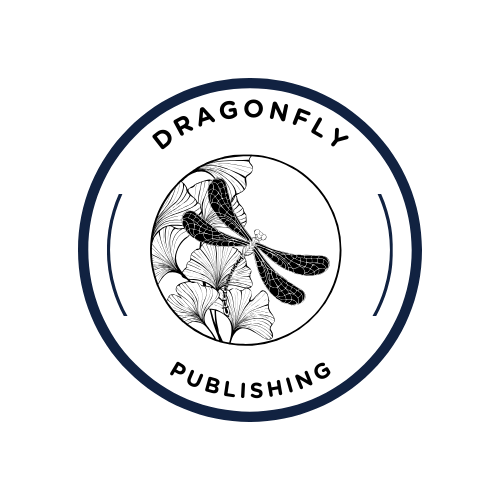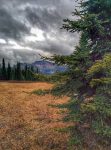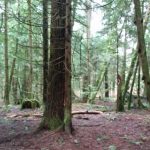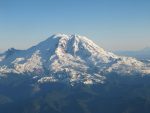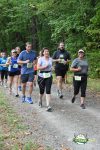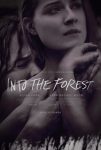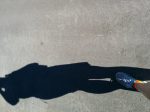I want to see mountains again, Gandalf, mountains, and then find somewhere where I can rest. In peace and quiet, without a lot of relatives prying around, and a string of confounded visitors hanging on the bell. I might find somewhere where I can finish my book. I have thought of a nice ending for it: and he lived happily ever after to the end of his days.
–from Lord of the Rings, JRR Tolkien
I love the mountains. I eventually landed in a home near the sea and the mountains after being raised in the great plains of the Midwest; it’s like this dream was always in the back of my mind. After living for a few years in southern California, where the dry coastal mountains rained ash during summer wildfires but stood gloriously snow-peaked through the winter–to my current home in Vancouver, BC–I have scaled my dreams. I’ve always been enamored by the sky’s majestic storm collectors. The first time I flew to Vancouver, in 2005 or so, the afternoon was clear and ice-blue, and I became mesmerized by the snow-capped mountains below, which nestled the chilled-to-the-bone waters below snaking their way through bluewhite fjords. Around that time I had been reading Lovecraft’s Mountains of Madness, so my imagination was running wild. Note that right now Netflix has a beautiful documentary, simply called Mountain, with Willem Dafoe reading selections from Robert MacFarlane. Words tangle with spirit-like mountains and haunting music. It is a cerebral film that makes you think as you get outside yourself and into the wild.

Robert MacFarlane, in Mountains of the Mind, stated:
Mountains seem to answer an increasing imaginative need in the West. More and more people are discovering a desire for them, and a powerful solace in them. At bottom, mountains, like all wildernesses, challenge our complacent conviction – so easy to lapse into – that the world has been made for humans by humans. Most of us exist for most of the time in worlds which are humanly arranged, themed and controlled. One forgets that there are environments which do not respond to the flick of a switch or the twist of a dial, and which have their own rhythms and orders of existence. Mountains correct this amnesia. By speaking of greater forces than we can possibly invoke, and by confronting us with greater spans of time than we can possibly envisage, mountains refute our excessive trust in the man-made. They pose profound questions about our durability and the importance of our schemes. They induce, I suppose, a modesty in us.
When I was a child, whenever we visited the Appalachian Mountains in Eastern Kentucky I would climb them with pure glee. And when I got older, I admired the great wide open western sky touched by peaks, though I can’t say I’ve ever climbed anything but the smaller coastal mountains where we live. And even then, just partially up, as it seems there’s always further to go in the next range over. I look outside now and can see Mount Baker in the distance, from our balcony. I go back to the fjords and white mountains, from my first flight here years ago, and lavish in the sense of both freedom and isolation the mountains give.
Whenever I’ve written fiction, it is generally set with an outdoorsy feel. And this is true for my new Wild Mountain series as well. The first book, Back to the Garden, was published as a new edition on October 16th. The previous version came out in print in 2013, but I updated the novel when I realized that I wasn’t done telling the story of Fran, Leo, Elena, Daniel, Buddha, Mei, Caine, Maisie, Joe, Jimmy, and Ishmael as they survived Wild Mountain in Idaho–a fictitious mountain. I had started the book with a quote by Dōgen Zenji: “The blue mountains are constantly walking.” In the book Practice of the Wild, Gary Snyder said:
“The blue mountains are constantly walking.” Dōgen is quoting the Chan master Furong. — “If you doubt mountains walking you do not know your own walking.” Dōgen is not concerned with “sacred mountains” — or pilgrimages, or spirit allies, or wilderness as some special quality. His mountains and streams are the processes of this earth, all of existence, process, essence, action, absence; they roll being and non-being together. They are what we are, we are what they are. For those who would see directly into essential nature, the idea of the sacred is a delusion and an obstruction: it diverts us from seeing what is before our eyes: plain thusness. Roots, stems, and branches are all equally scratchy. No hierarchy, no equality. No occult and exoteric, no gifted kids and slow achievers. No wild and tame, no bound or free, no natural and artificial. Each totally its own frail self. Even though connected all which ways; even because connected all which ways. This, thusness, is the nature of the nature of nature. The wild in wild.
So the blue mountains walk to the kitchen and back to the shop, to the desk, to the stove. We sit on the park bench and let the wind and rain drench us. The blue mountains walk out to put another coin in the parking meter, and go down to the 7-Eleven. The blue mountains march out of the sea, shoulder the sky for a while, and slip back to into the waters.”
This is how I feel as well–almost–I am freer in the mountains and they do feel sacred, but also feel thus–and in my story the mountains walk too, because in part two of the series, To the Waters and the Wild, there will be a new wild mountain while the necessity of home travels with the family.
When reviewing Jeff VanderMeer’s novel Borne, the New York Times wrote that eco-fiction (which has been around since the 1970s) “has come of age as well: wilder, more reckless, and more breathtaking than previously thought.” Back to the Garden was originally conceived of in this light. It is a novel portraying a world whose characters narrate a journey with the nostalgia of the world as we know it today, but who also have survived a tipping point and have been ushered into a new wilder world. Not that I could have foreseen the NYT’s take on this literature, but in a way, many authors are perceiving similar ideas because we aren’t just writing. We are imagining, we are researching, we are warning, we are hoping, we are kind of going a little crazy and wild. Fiction is a great place to do this in, and though eco-fiction may not be a boxed in or neat little genre, it can act as kind of an umbrella to the numerous novels that exalt nature or tackle human impact on the environment–and may help to categorize the various literary or speculative novels that try to capture the hyperobject that is climate change. Eco-fiction feels more like a big concept rather than a genre; newer genres also capture climate change and various ecopunks; I’m not tied to any as a classification when it comes to describing my own work, which is also a romance, a journey, a culture, a family/friend-based story.
As an author, my heart is always with my debut novel, and I went back and forth between continuing it or branching off into different projects (two others are in the works, including Up the River and an ecological weird fiction novel that may become a short story instead). But I’ve decided to put Up the River on hold because the more I thought about Back to the Garden, the more I read it, the more I realized that my heart really is into continuing it, and that time seems to be now instead of later–whereas my other projects, though they are coming along, will be postponed at least until Part II of the new Back to the Garden series is complete.
Part II, To the Waters and the Wild, is in the works and begins on Wild Mountain in Idaho, where Part I ended. It is told in the eyes of the children born to the tipping point survivors. However, Idaho becomes too hot and dangerous to continue to live in, and so the families decide to pack up and move up to Canada’s northwest coast to build a new homestead.
Why I am personally excited about this series is that I believe that with new experiences, authors evolve and find new ways of storytelling. I am eager to incorporate some new thoughts floating around in my head into this story I began writing in the mid-2010s. After the publication of the first novel, I visited Ireland and renewed my long interests of myth in fiction. You may have noticed that Part II is a direct nod to William Butler Yeats, from “The Stolen Child,” and part III of the series is actually titled The Stolen Child. Two summers ago I spent time hiking, running in, and visiting parts of Ireland. Running around and admiring the pastoral and sometimes isolated country of Yeats’ youth sure did bring a lot of exciting new ideas to mind, some of which I had really planned to explore in my weird fiction project, but find now that I can fit these ideas in to the Back to the Garden canon.
I have to admit too that, like many, I have been a little submerged in disbelief regarding the Trump era, but deep inside I feel a lot of hope and inspiration by being outside, with the mountains as a constant–this kind of feeling, this being in nature, is ultimately freeing. While Up the River is a response to Trump’s fossil fuel decisions and my own research about Canada’s oil sands, I realize that though I really love the project and plan to complete it, right now I need to feel motivated not by fossil (old) politics, which I believe to truly be temporary, but by the larger aspect of freeing myself from these issues of a weeping world, while trying to warn about our future. I am not much of a political writer–more of a speculative writer who bends genres–and if I need to tackle issues, I feel I do best by breaking out of political anguish and letting myself go into into the wild. This is, by the way, a big component of some of Yeats’ work, whose physical poetry said essentially that embracing nature can liberate us. Not just embracing it as a concept but being in it, celebrating it, preserving it, admiring its power, and understanding and accepting the side of nature that isn’t comfortable to us humans who like climate-controlled abodes and plenty of materialistic conveniences (our trappings). Yeats said, “Come Away” in more than one poem, but in “The Stolen Child,” he asks us to come away to the waters and the wild. I have run in Sleuth Wood mentioned in “The Stolen Child,” and boated to the “Lake Isle of Innisfree” (a real island in Lough Gill). The idea of going “to the waters and the wild” is my muse, and I am eager to address it when writing the rest of the series.
Nature ideas are being searched in modern eco-fiction, and they will be central in the continuation of Back to the Garden as the Idaho troupe travels again to a place we might consider wilder, mythical, impossible, and even reckless. Though dystopian in nature, there is hope, and there is tension: romantic drama and the growing knowledge of (and intersection with) a sect of survivors who are in a cult and have inherited some of the modern ideology we see today that has led us to environmental catastrophe. I believe the addition of To the Waters and the Wild will appease those readers who didn’t get enough “what happened before” intel as well as tell more of a story than Part I, which was what may be seen as an account of a newly born myth.
1. [Regarding Jeff VanderMeer’s newest novel Borne] This coming-of-age story signals that eco-fiction has come of age as well: wilder, more reckless and more breathtaking than previously thought, a wager and a promise that what emerges from the 21st century will be as good as any from the 20th, or the 19th. (“There’s No Escape From Contamination Above the Toxic Sea,” May 5, 2017)
Now enjoy some of the mountains I’ve walked with during the past few years:












